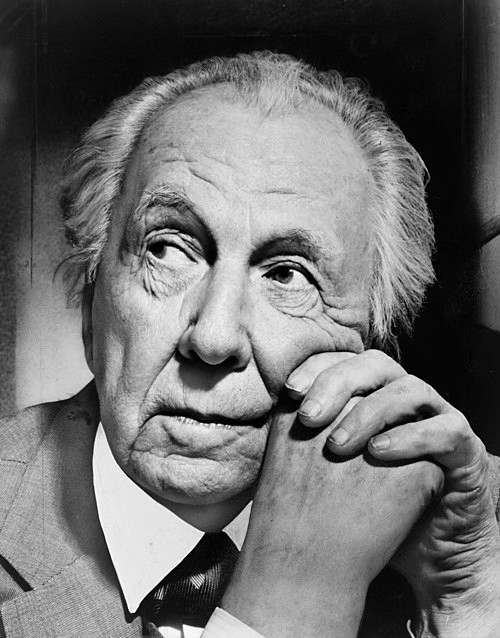
“What great State has not been eventually ruined by the ‘patriotism’ of conscienceless public servants? History has no conflict on this point. All have died of exploited FEAR.” – Frank Lloyd Wright, “Wake Up, Wisconsin” (1952)
If you read Frank Lloyd Wright’s commentary on democracy, you may think he is living in the United States in 2025. Wright, the pioneer of modern organic architecture, was born at the end of the American Civil War in 1865 and lived until 1959, the height of the Space Race between the U.S. and the Soviet Union.
Wright designed The Guggenheim Museum in New York as well as the campus of Florida Southern College, which lies just 65 miles from Rollins College.
He called his later style the “Usonian” style to embody the United States middle class, and he did not design to dominate. Wright designed very few skyscrapers, only one of which was built, and was wary of building anything that lost sight of the earth. Although his best-known domestic designs in Pennsylvania and Chicago were for well-to-do clients, he also tried to make homes that were affordable for common people in the early 20th century.
For Wright, architecture was a social force as well as an aesthetic one. The Frank Lloyd Wright Foundation writes that Wright “devoted his life to creating a total aesthetic that would enhance society’s wellbeing.” It’s no surprise, then, that he also made very public political commentary throughout his life.
In a review of Kenneth Frampton’s 2017 essay collection “Wright’s Writings: Reflections on Culture and Politics 1894-1959,” architecture magazine Metropolis highlights several of Wright’s comments on American politicians.
Wright also wrote of the dangers of American politicians, using fear as a political tactic in a 1952 letter called “Wake Up Wisconsin.”
Wright himself feared the effects of the American public, which he coined the “mobocracy,” because it was not educated or eager to shape its government and culture. “We are the victims of moral cowards putting up a sham fight. What great State has not been eventually ruined by the “patriotism” of conscienceless public servants? History has no conflict on this point. All have died of exploited FEAR.”
“Fear is the real danger in any democracy. Our worst enemy now is this craven fear managed by conscienceless politicians. Scare the mob! Huddle the timid voters at the polls and a politician gets what he wants by exploiting their fears. Mobocracy, afraid, can always bid more votes than true democracy, unless aroused, can ever hope to counteract,” he said.
When the world’s most famous architect is an outspoken pacifist, anti-nationalist, and anti-authoritarian activist, it draws attention. In particular, it drew attention from the FBI.
Just after the US became involved in World War II, the FBI honed in on Wright and his Taliesin estate in Wisconsin. A federal judge accused him of telling his apprentices to avoid the draft by applying for conscientious objector status. They amassed a thick file of criminal accusations and tips from citizens accusing Wright of communism.
They also took note that on nationally broadcast television, Wright suggested that First Lady Mamie Eisenhower contain her husband’s military impulses. During a time of anti-communist frenzy, such behavior would easily garner government interest.
Wright had a lot more to say, of course. As Audrey Gray put it in that same “Metropolis” article, “he warned America a long time ago that the executive branch could overstep with the media’s help.”
Gray explained this using a quote from Wright’s self-published Taliesin Square-Paper in 1941:
“With this elected president cheerfully making a role for himself never intended for the president of this republic, in any circumstances whatsoever, the role of ruler, we the people of this country, unable to see clearly, are sinking deeper into fatal coma—we are less and less able to recognize ourselves as a free, independent nation.”
Continuing on, he said, “Instead of an honest forthright independence, all we know is what we read in the papers and all the papers know is what they think is good for the people to know in the circumstances.”

Architecture and Political Ideology
Wright’s beliefs of individualism in architecture were politically colored. He was both a pacifist and a true patriot, who believed architecture was the “mother of all the arts.”
During his time, America struggled with both its political identity and architectural identity—most Americans wanted their buildings to be fashionable and European-inspired, which Wright despised.
His outlook is nearly identical to that of the character Howard Roark from Ayn Rand’s “The Fountainhead,” one of the most classic novels of individualism. Rand was the famous Russian philosopher who created a brand of libertarianism that inspired the American Conservative Party—she notably did not endorse any political group, supported the right to abortion, and hated that political conservatives were entangled with organized religion.
Many believe that Rand based Howard Roark off Frank Lloyd Wright. The book centers around two fundamentally different people. Peter Keating amasses money and fame by copying the classical European style of architecture, deceiving friends and coworkers and using Roark’s help and ideas to advance his career without giving him credit. Roark is ostracized for his modernist designs that are inspired by the natural landscape, turning down projects that conform to classical conventions, even if it lands him in poverty or requires him to quit architecture. He designs buildings that suit their inhabitants while never compromising his stubborn convictions.
In essence, a person’s taste in architecture can illuminate their worldview. One of President Donald Trump’s first executive orders that got lost in the shuffle was reinstating his first-term policy that requires government buildings to be built in “classical” styles instead of modernist ones; such traditional styles include Greco-Roman, Renaissance, Beaux-Arts, and Georgian styles. The order even specifies which architects to imitate, such as John Russell Pope, who built the National Archives.
Frank Lloyd Wright and Howard Roark would be gravely disappointed by the Beautiful Federal Civic Architecture executive order, which aims to promote nationalism and encourages architecture that “commands public admiration.”
The list of acceptable architects to emulate notably omits Frank Lloyd Wright, the most beloved American architect of all time. He believed a nation’s buildings can tell a lot about its values and can shape political attitudes. As the Frank Lloyd Wright Foundation said, he loved Whitman and Emerson and focused on celebrating the natural landscape and individualism in his designs. It was not arrogant as it intended to join humans with nature and build relationships between inhabitants of the home based on furniture, lighting, and placement of gathering spaces.
In his book “When Democracy Builds,” Wright said that what Americans should pursue is “an architecture that seeks to serve man rather than to become… one of those forces that try to rule over him.”
Wright’s ideas about American democracy warrant reflection right now, and his building style, based on mutual respect and individualism, should be considered when prescribing how American public buildings are built. He would have viewed Trump’s order and autocratic moves as a betrayal of the essence of American character.
“A free America… means just this: individual freedom for all, rich or poor,” said Wright. “[O]r else this system of government we call democracy is only an expedient to enslave man to the machine and make him like it.”
The opinions on this page do not necessarily reflect those of The Sandspur or Rollins College. Have any additional tips or opinions? Send us your response. We want to hear your voice.






Comments are closed.